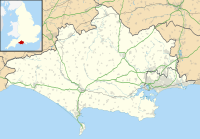User:Huligan0/Bindon Hill
Bindon Hill is an extensive Iron Age earthwork enclosing a coastal hill area near Lulworth Cove in Dorset, England.
Location[edit]
The Hill is located about 19 kilometres west of Swanage, about six kilometres south west of Wareham and about 17 kilometres south east of Dorchester.
Bindon Hill is only accessible when the Lulworth Military Range is open to the public. It can be reached by a short walk from West Lulworth, or alternatively via the South West Coast Path from Lulworth Cove. The Range is owned by the Ministry of Defence (MoD) and is part of the Armoured Fighting Vehicles (AFV) Gunnery School. The 7,500-acre (30 km2) range lies within an Area of Outstanding Natural Beauty and stretches along the Jurassic Coastline between Lulworth Cove and Kimmeridge. Visitors are advised to keep to official footpaths and abide to local site notices, because tanks and Armoured vehicles are used in this area. Safety warnings about explosives and unexploded shells are posted nearby by the MoD and there is a flashing warning lamp situated on the hill, which is illuminated when the range is in use.[1]
Hill fort[edit]

The main rampart and external ditch (univallate) run for over 2 km along an east-west ridge parallel to the coast, which lies about 750 m to the south. The ridge rises to 168 m and the cliffs are 30-120 m high. At the western end, an incomplete series of ramparts curve back to the cliffs of Lulworth Cove. At the eastern end, the main rampart reaches the cliffs on the north side of Mupe Bay. The total enclosed area is about 110 ha.
The enormous enclosed area, lack of evidence of settlement in the interior, and the impossibility of effectively defending such a large perimeter, all suggest it was primarily an enclosed pasture for domesticated animals, not a strategic tribal hill fort.
Jurassic Coast[edit]
The Jurassic Coast, a UNESCO World Heritage Site, stretches over a distance of 153 kilometres (95 mi), from Orcombe Point near Exmouth, in the west, to Old Harry Rocks on the Isle of Purbeck in the east [2].
The coastal exposures along the coastline provide a continuous sequence of Triassic, Jurassic and Cretaceous rock formations spanning approximately 185 million years of the Earths history. The rocks dip towards the east. Due to this tilting and erosion the oldest exposed rocks are found in the west with progressively younger rocks forming the cliffs further east. Bindon Hill lies above Fossil Forest and they are part of the Jurassic Coast.
References[edit]
- ^ "Safety and access restrictions: Lulworth ranges". Retrieved 2010-11-16.
- ^ "Dorset and East Devon Coast". UNESCO World Heritage Centre. 2001. Retrieved 2010-11-16.
{{cite web}}: Cite has empty unknown parameter:|coauthors=(help)
Bibliography[edit]
- The Jurassic Coast Trust (2003). A Walk Through Time, the Official Guide to the Jurassic Coast. Coastal Publishing. ISBN 978-0-9544845-0-7.
{{cite book}}: Cite has empty unknown parameter:|unused_data=(help) - Barry Cunliffe (1974). Iron Age Communities in Britain. ISBN 978-0-7100-8725-6.
{{cite book}}: Cite has empty unknown parameter:|unused_data=(help)

